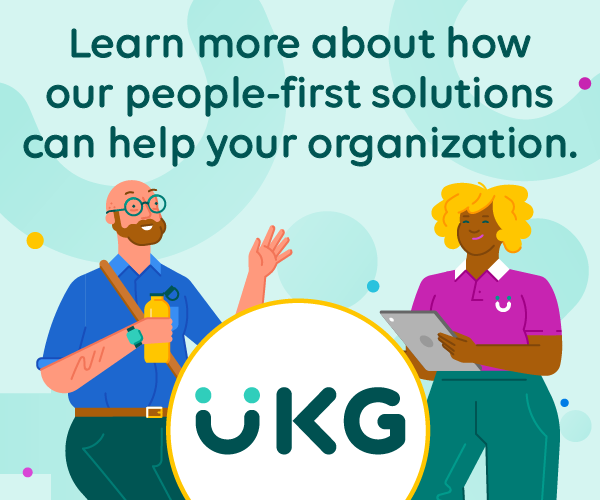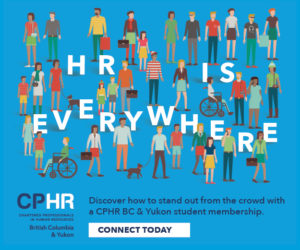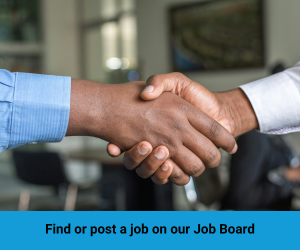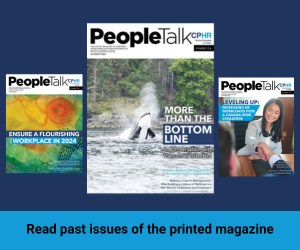Real-time HR: The Future is Present
None of us can predict the future. But based on how human resources is practised now compared to decades ago, there’s no doubt that the future will reflect significant change, just as it will retain its key underpinnings in real-time HR.
Both the role and the mechanics of HR have changed significantly in the two decades he’s worked in the field, says Jose Dino, director and general manager of TELUS Employer Solutions. In many ways, the latter has enabled the former.
“Compared to 20 years ago, when HR was more administration-based, we’re now here more to enable and partner with the business,” Dino says. “Technology has enabled organizations to streamline formerly paper-based systems so they can better attract, retain and develop the right talent.”
“One of the trends I see is better workforce analytics. In the past, all the data was gathered from different systems; now you can see it all on one screen. Accessibility to the data makes it easier to predict behaviour or trends, too,” says Dino. “I like the saying, ‘The question is the answer.’ You start with the question, look at the data and then dig further based on what the data showed you. You investigate in the directions that the data directs you.”
“We’re re-learning how to use data,” he adds. “Business intelligence for HR, gained from workforce analytics and workforce intelligence, will become more important as talent management gains importance. It will enable the predictive use of analytics.”
Much Ado About Data
“Lots of organizations are moving to cloud-based technology; they have to be really careful with where their information resides,” Dino says. “We have strong rules around privacy and security here in B.C.”
As leader of the privacy group at Harris and Company LLP, Suzanne Kennedy can tell you about those rules and how technology has impacted privacy.
“First, consider how much information we’re recording and can store. We’re creating a written record of pretty much anything that happens. We’re using email and texting for the banter that used to happen at the water cooler. People need to be careful what they say, especially when they’re frustrated,” Kennedy says. “We need to be conscious of what, how and why we’re recording any information. There’s a huge privacy impact in how much we’re collecting and retaining – sometimes more than we need.”
“Second, there’s so much new technology that we rush to implement it without considering the privacy aspects of it. For example, surveillance includes videotaping, but also using the GPS on smart phones, monitoring internet and email usage, or monitoring employee entries and exits through their key cards,” Kennedy explains. “It’s become very common, and employees may not even realize what information their employer is collecting.”
All of this is only good if it’s implemented in a thoughtful way, she adds. “Often, we’re recording just because we can, but are not asking ourselves if we should be recording it.”

Suzanne Kennedy
Collecting Data With a Purpose
Kennedy recommends establishing what your intention is and how you might use the information you capture. Then be clear and transparent with employees about it. “When you’re dealing with privacy, you need good communications, including notifications and signage that explain what you’re doing and why.”
“Generally, you can’t collect information for one purpose and use it for another,” Kennedy cautions. “Most surveillance is for the safety and protection of people and assets. But sometimes people add more surveillance for those reasons without thinking through the privacy impact.”
For example, an agricultural employer accused of abusing animals might decide all employees should wear body cameras so they can prove they’re not abusing the livestock, but hasn’t thought through the privacy ramifications of having a camera on every employee.
How Well-Travelled Is My Data?
Where you store your data can also create security risks. B.C.’s public sector is prohibited from storing personal data outside Canada, but every organization should carefully consider where it stores its information.
Information is subject to the laws of the jurisdiction where it resides, so any data stored in the U.S. becomes subject to the USA Patriot Act.
And while it’s okay to have information stored in the cloud, organizations need to understand their service provider’s storage location and where it routes data. It may restrict which companies the organization can deal with, but is worth investigating. If data is going to be stored outside Canada, a company should let its employees or customers know that.
Privacy breaches can be raised in labour arbitration, or result in claims for civil damages. In 2015, when hackers obtained user information from Ashley Madison, a commercial website billed as enabling extramarital affairs, a certified class action suit by site users asked the company for hundreds of millions of dollars. The suit was settled before it went to court.
“There also needs to be more discussion of how much data is out there,” Kennedy says. “When biometrics and facial recognition are combined with other pieces of data, it can reveal a lot about an individual.”
Overall, the need for surveillance for safety or investigative reasons must be balanced with how invasive it will be for the individuals involved.
HR Technology Pains and Gains – Focus on the User Experience
As vice-president of HR and corporate secretary at BC Transit, as well as serving as chief mentor for FreshWorks Studio, Greg Conner, FCPHR has seen that balance at work for the better: “A visible positive result of technology is employee self-service for mundane things, allowing information to be readily available at any time.”
Conner also believes the HR profession can go even further.
“It does concern me how slow we are in treating our employees as well as we treat our customers. For example, I can do all my banking online within an easy format, yet in organizations we have ugly systems that don’t have good user experience,” Conner relates.
Change, especially in technology, Conner says, “must concentrate on the user experience from the beginning, because it will work better in the end.”
“Bad processes can result if technologists create things in a vacuum—you need user experience,” he emphasizes. “For example, a technologist may place something where it needs the shortest cable, but it’s not in a handy spot for the actual user. But once it’s been put there, you’ll have to fight to change it because people don’t want to admit they made a mistake.”
Involving a people-first perspective from the beginning can prevent such issues.
That said, Conner points to many successful changes in real-time HR enabled by technological advances, such as the positive impact on performance management completion and the resulting opportunities, making learning management available 24/7 and pre-sorting job applications—so that HR professionals can have deeper, more meaningful discussions about the merits of the top candidates instead of spending time winnowing resumes.
“When technology works right, it really frees up HR to be strategic and meet business needs,” Conner says. “For example, instead of looking at the overall employee retention rate, we can look at it specifically for our above-average and high-potential employees, and examine how to add value for those people so they stay.”
eLearning Continues in the Workplace
For Sandra McDowell, CPHR, founder of the eLeadership Academy and vice-president of people and culture at First Credit Union, the list of benefits from technological changes is a lengthy one, encompassing learning and development, data gathering and analysis, communication, recruitment and automation.

Sandra McDowell, CPHR
While acknowledging that it can lessen person-to-person human connection, McDowell points to how technology has improved long distance connections—elevating conference calls to video conferencing and even 3-D holograms that give new meaning to attending in person.
Those changes bring opportunities to those who embrace them.
“It seems like not more than five years ago, social media wasn’t the place to recruit,” says McDowell, who has also authored Your Mother Was Right: 15 Unexpected Lessons about Leadership and the Brain. “Now it’s proven to be the most effective way of sharing job postings and targeting talent.”
For McDowell, the biggest change is our growing understanding of how the human brain works. While technology has made it easier for colleagues to reach out to others around the world, the lack of face-to-face connection is increasing loneliness and stress.
“The primary costs have been that people’s feeling of connection has decreased and mental health issues have increased,” McDowell says. “In a world where we have never been more connected through technological innovation, we are experiencing an epidemic of loneliness.”
On the other hand, she believes online learning and development continue to improve real-time employee experience. “Online learning cuts costs, saves time, and offers convenience and brain-friendly learning which improves retention,” McDowell says. “It meets employees where they are at and solves the complexity of providing training solutions to geographically-disperse workforces.”
Understanding How our Brains Work & Looking After Them
Armed with current knowledge of how human brains work, McDowell developed the successful ’brain-friendly’ leadership training offered through eLeadership Academy, but the focus is far from solely tech. “The biggest opportunity is in teaching people self-awareness, emotional intelligence and soft skills. We’re using technology to teach people the things technology can’t: emotional connections, creativity, problem-solving,” she says.
“People are tapped out, stressed, busy, overwhelmed. We need to create the conditions to learn and create a new understanding. Like Goldilocks in the three bears’ house, everything has to be just right. We need to carve out new neuropathways and that takes work,” says McDowell. “Good learning conditions include good self-awareness, and an understanding of what’s working and what’s not. There needs to be an understanding of the importance of focus and of not having to be ‘on’ all the time. You need a space without distractions and to break the learning into bite-size pieces. Then people can learn to change their habits.”
People are trying to do so much multi-tasking and are being bombarded with so many requests and so much information, that they are losing their ability to focus, she adds. This, however, is a relatively new phenomenon that can be reversed with training and practice.
“We need to understand that our cognitive ability is under fire,” emphasizes McDowell. “We need to foster brain health with brain-friendly, dispersed learning. The biggest benefit is our ability to think.”
Keeping a Human Connection in a Changing Workplace
Dino has seen similar challenges in maintaining human connections. “We have lots of mobile workers or those who work from home. They view it as a good thing: flexible schedule, no commute or paying for parking.
“But it’s crucial to have human interaction, whether in person or via technology. We use conference bridges and Webex to reach out to team members, but we also make a point of seeing everyone regularly. An organization has to be conscious of isolation and maintain a level of human interaction,” says Dino.
“Human interaction is absolutely as important now as it ever was. You have to find that balance while viewing technology as something that enables the business to make intelligent decisions around its workforce,” he offers. “It’s up to HR to ensure the organization still has that human touch with employees.”
“HR is the steward for ‘humans’ in our workplaces,” McDowell concurs. “Humans are tribal by nature. Our brains are hardwired to understand that we are stronger together. And when we feel alone and disconnected, our brains feel threatened, and are on guard. Connection between humans stimulates the release of ‘feel-good’ chemicals and neurotransmitters in the brain.
“When we connect with others, our parasympathetic nervous system kicks in which stimulates the vagal nerve, which calms us down and makes us feel connection,” she says. The vagal nerve is like a highway that connects your body and your brain. These emotional and social experiences positively affect our physical health.”
Human Interaction, More Important Than Ever
Conner sees that need for human interaction becoming more intense in the future. “I think our interactions will be even more important as we work on more complex questions, focused on business outcomes. They’ll be Tier Two or higher-level, discussions. What used to be done in Tier One conversations can be automated,and HR will be able to work with client groups to add value.

Greg Conner, FCPHR
“I love communicating with staff. I try to make the communications human,” Conner says. “if you don’t, the things people make up are beyond belief because they’re not involved in the process.”
When people and change come together, he admits, there is s often fear. “Anytime technology changes, there’s fear about losing jobs, especially in administrative roles,” Conner says. “There’s more and more fear all the time. For example, people talk about autonomous buses, but that day is far away, and they’ll augment, not replace, bus drivers.”
“Because the brain prefers routine and to conserve energy, it naturally resists learning new things,” McDowell explains. “When there’s something new, we have to think more. I’ve seen apprehension for every tech advancement I can think of in HR and within overall operations.”
Overcoming Resistance to Change in the Workplace
When BC Transit introduced key changes in technology, it made sure to hold meet-and-greet sessions and put up demonstration terminals for weeks so that employees could see the value, what they could use the tools for and how to use them, Conner explains.
It’s especially important to include employees who don’t work in traditional settings. For BC Transit that includes 600 people who don’t work in offices—primarily transit operators and maintenance staff.
“Change doesn’t always come easily,” Conner says. “Three years ago, it took us a year and a half to persuade our IT department to issue emails to transit operators, many of whom don’t come into an office. ‘No one’s going to use it,’ they said. ‘They don’t have email on their phones.’
“In fact, 98 per cent of operators have smart phones and currently, more than 65 per cent use the email daily and almost 85 per cent use it weekly.”
Dino recalls being HR director at TELUS when they reformed the department and automated many functions. Those changes stemmed from a company at a retail conference approaching Dino after he spoke about their HR technology being a big part of their transformation; they wondered if TELUS sold the technology too?
“We said ‘No, but we can license it,’” recalls Dino. “That company became one of our first customers for PeopleSoft.”
As a result of those changes, TELUS now offers HR solutions to customers across Canada, mostly through the its PeopleSoft human capital management system, freeing up capacity within the clients’ own HR departments. Those clients now include retail, service and government organizations from across Canada.

Jose Dino
Focus on Tomorrow Today
“We need to elevate change management to a key program deliverable in its own right,” Conner says. “Change is never ‘done and dusted.’ You need to do a post-mortem, see what needs changing and change it, as many times as needed, or you will never get full acceptance. It’s an ongoing, iterative process.”
Dino agrees. “Change management teams need a dedicated communications team working closely with stakeholders, as well as training and revived business processes. They’re all vital to success, but they’re not always there.”
McDowell believes consideration for how the human brain works should also be part of change management. “That is how we gain the capacity for sustainable change.”
Whatever changes the future brings to real-time HR, keeping the “human” in human resources will remain a priority.
“If you want great people, you need to develop them. You need to understand who they are,” Dino says. “Business moves at a different speed now. There are so many decisions to make. Technology is there to help us make smart ones.”
Nancy Painter is an award-winning communication consultant and writer based in Surrey. She is an active member in both the International Association of Business Communicators and the Professional Writers Association of Canada.
For the latest HR and business articles, check out our main page.








